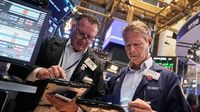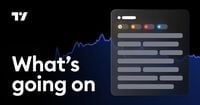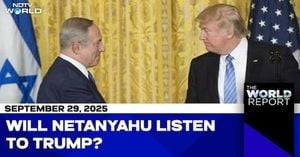As the clock ticked down to midnight on September 30, 2025, Washington found itself on the brink of its first government shutdown since 2018. Despite the looming threat, U.S. stock markets rallied into the final days of September, with major indexes posting gains and investors displaying a curious mix of caution and optimism. The standoff over government funding, which has become a familiar drama in the nation’s capital, cast a long shadow over Wall Street, economic policymakers, and ordinary Americans alike.
According to Reuters, the Nasdaq Composite rose by about 0.5%, the S&P 500 by 0.3%, and the Dow by 0.15% on September 29, 2025. Tech and growth sectors led the charge, with Nvidia up roughly 2%, and Electronic Arts (EA) surging after announcing a blockbuster $55 billion go-private buyout. Meanwhile, safe-haven assets like gold spiked to an all-time high of around $3,860 per ounce, reflecting a market hedging its bets as government funding teetered on the edge.
Yet, beneath the surface, anxiety simmered. The shutdown, triggered by a deadlock in Congress over how to fund the government, threatened to disrupt the release of crucial economic data. The Bureau of Labor Statistics (BLS) confirmed that if the shutdown proceeded, Friday’s payroll data—a key gauge for markets—would not be published. UBS’s Paul Donovan warned in a note that the absence of official data could allow “rumor and unreliable survey evidence to gain influence over markets.” He added, “This all lowers the productivity of economists … as pointless hours are spent analyzing the effects.” Donovan’s concerns were echoed across the financial world, as traders and policymakers alike braced for a period where sentiment, rather than facts, might drive decisions.
Macquarie Group’s Thierry Wizman pointed out that while the macroeconomic impact of most government shutdowns is small and quickly reversed, the risk rises if the impasse drags on. Referring to the last shutdown in 2018, Wizman noted that real GDP was reduced by 0.1% in the fourth quarter of 2018 and by 0.2% in the first quarter of 2019. However, he emphasized that “only a very small (0.02%) of GDP is permanently ‘lost.’” The real danger, he suggested, would be if President Trump followed through on threats to permanently cut furloughed workers, a move that could deepen the economic impact and raise questions about the governability of the U.S.
Despite these risks, investors largely brushed off shutdown worries, focusing instead on resilient economic data and the prospect of Federal Reserve rate cuts. Market strategists, as reported by Investopedia, emphasized that past shutdowns have typically caused only shallow, temporary dips in the markets. Lindsey Bell of Ally Invest observed that investors are “clinging to the positives,” such as hopes for rate cuts and strong corporate earnings. Ritholtz’s Callie Cox likened the shutdown risk to “a slow car crash” that markets can manage if it’s brief.
Meanwhile, the Federal Reserve’s upcoming meeting on October 28-29, 2025, loomed large. Traders were pricing in a roughly 90% chance of a 25-basis-point rate cut, and Fed officials struck a broadly dovish tone. New York Fed President John Williams stated that recent signs of labor-market weakness increase his support for rate cuts. However, the shutdown threatened to complicate the Fed’s decision-making process by delaying the release of vital economic reports. As the Labor and Commerce Departments warned that data releases would pause during any shutdown, some analysts cautioned that the Fed might have to rely on private data—potentially trimming the likelihood of an October cut, but “only marginally,” according to Bank of America.
Corporate America, for its part, took the uncertainty in stride. Jefferies reported record investment banking advisory fees, fueled by a dealmaking boom. CEO Brian Friedman told Reuters, “Interest rates are starting to come down, the economy is holding up, business confidence is reasonable and, as a result, M&A activity continues to pick up.” Electronic Arts’ announcement of its $55 billion buyout—the largest leveraged buyout ever—underscored the strong investor appetite for tech and entertainment assets. Robinhood Markets, too, spiked about 12% after its CEO touted record growth in its prediction markets.
On the policy front, the Securities and Exchange Commission (SEC) announced it would fast-track a proposal to scrap quarterly earnings reports, aiming for a shift to semiannual reporting by late 2025. This move, in line with President Trump’s push for reduced compliance burdens, has drawn mixed reactions. Proponents argue it will cut costs, while critics warn it could reduce transparency and add volatility to already jittery markets.
Amid all this, companies may have found an opportunity in the chaos. UBS’s Donovan noted that firms could quietly implement price hikes during the shutdown, knowing that they would go largely undetected until inflation reporting resumed. By the time consumers realized, they would have already adjusted their perceptions—and their wallets. “Companies can sneak through price increases—for profit as opposed to being tariff-driven—because they know it will go ‘undetected’ for some time,” Donovan explained.
Looking ahead, analysts and investors are watching the calendar closely. The September jobs report, originally scheduled for October 3, may be delayed, adding another layer of uncertainty. RBC Capital Markets forecasts U.S. GDP growth of around 2.0–2.5% next year if inflation cools and policy remains supportive. Yet, as Bloomberg Intelligence’s Mike McGlone cautioned, any “euphoria” could be fragile once the shutdown uncertainty resolves.
Market bulls point to historical resilience. Goldman Sachs analysts recently boosted their year-end S&P 500 target to 6,800, citing robust corporate earnings and strong policy support. Jefferies’ Friedman expects dealflow and confidence to stay high as interest rates ease. But others, like Société Générale, warn that U.S. stocks are now nearly 30% above their April lows, and Fed Chair Jerome Powell has flagged equity valuations as “fairly highly valued.” Oliver Pursche of Wealthspire added, “There needs to be another strong catalyst” to push stocks much higher after a third straight year of double-digit S&P 500 gains.
For now, the markets appear to be treading a fine line—buoyed by optimism but hedged against potential shocks. Investors are keeping a close eye on upcoming labor and inflation data, as well as the progress of government funding negotiations through October. As one strategist put it, the shutdown is “a well-worn routine and very often a solution is created at the last possible moment.” Whether this time will be any different remains to be seen, but one thing is certain: the world is watching, and so are the markets.
In the days ahead, the interplay between political brinkmanship and economic reality will test the nerves of investors, policymakers, and everyday Americans alike. The only certainty, it seems, is uncertainty itself.







